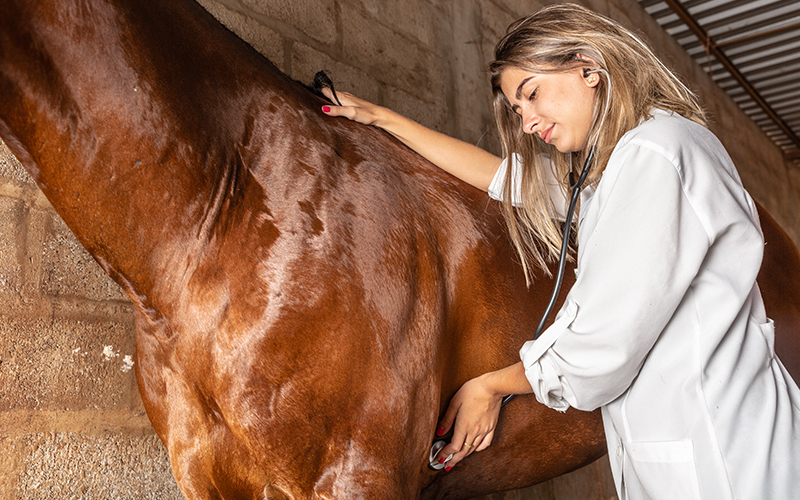Inflammatory Airway Disease in Horses

What is Inflammatory Airway Disease?
Inflammatory Airway Disease (IAD) is also described as mild to moderate Equine Asthma. IAD is a respiratory disease that typically affects young horses, as early as one year of age. Cough, poor performance and excess mucus within the airways on endoscopy is characteristic of IAD. This disease differs from other horse respiratory conditions like heaves, in that affected horses typically do not show increased respiratory efforts at rest. The exact cause is unknown, but is thought to be associated with inhalation of irritants such as barn dust and air pollution.
How can you tell if a horse has IAD?
Horses with IAD are generally bright and alert, with good appetites and an otherwise healthy appearance. They may display the following respiratory abnormalities:
- Long-term (one month or longer) cough without a fever
- Poor or decreased performance with more strenuous work
- Longer respiratory recovery rate after work
- Mild watery to white nasal discharge, particularly after exercise
- With worsening disease, horses can become exercise intolerant
How is IAD diagnosed?
Your veterinarian will begin with a thorough physical examination and history. Diagnostic tests are required to differentiate IAD from other diseases such as heaves, bacterial infections, viruses and sometimes parasitic infections that can have similar symptoms. One common test is to pass an endoscope in the airways after exercise to see if excess mucus if present. Another helpful test is to perform a lung wash (bronchoalveolar lavage or BAL), which examines different types of cells lining the airways deep in the lungs. Alternatively, mucus and cells may be collected from the trachea (tracheal wash). These tests will help your veterinarian rule out infections and distinguish between possible causes. Sometimes, more advanced testing can be performed to rule out other causes of decreased performance and confirm IAD. Often these tests can only be performed at specific referral centers.
How is IAD treated?
The approach to IAD treatment is three fold:
Decrease exposure to irritants horses are exposed to in the environment (e.g. hay dust, barn and arena dust)
Treat airway inflammation
Expand the airways that are abnormally constricting
1. Decreasing exposure
The most important factor in improving your horses’ health is to decrease environmental irritants especially hay dust. Completely removing hay from the diet can help accomplish this goal. Horses manage well on pelleted complete feeds or soaked hay cubes. These feeds provide sufficient fiber levels in a horses’ diet such that they can be maintained without any supplemental forage. Alternatively, feeding steamed hay or haylage reduces exposure to dust and helps reduce airway irritation. Other dust reducing techniques include changes in housing, ventilation, bedding and lifestyle. Horses with IAD manage better on paper or wood shavings bedding versus straw or hay. An IAD horse would benefit from being out on pasture regularly, with 24 hour turnout being ideal. This may be impractical, however, as many IAD horses are in active training. If it is impractical to house a horse on pasture, the following changes can be made to help reduce dust exposure:
- Remove horses from the barn prior to cleaning stalls and feeding.
- Avoid using a leaf blower to clean barn.
- Keep horses out of the barn until at least 1 hour after chores are completed.
- Bed horses on wood shavings, cardboard or pelleted bedding versus straw or hay.
- Feed hay from the ground and wet it down. Alternatively, feed steamed hay or haylage.
- Avoid feeding in deep bins and avoid feeding round bales.
- Provide good ventilation.
- Keep stall windows and barn doors open to allow fresh air flow.
- Pick up clutter in the barn and tack room to decrease areas where dust can settle in the environment.
2. Treat Airway Inflammation
Corticosteroids are the most frequently used anti-inflammatories for the treatment of IAD. These drugs can be given orally (prednisolone), injected (dexamethasone, triamcinolone acetonide) or inhaled by your horse (beclomethasone, fluticasone or budesonide). Several commercially available equine inhalers exist. Another therapy that recently showed promise is supplementation of feed with omega-3 fatty-acids.
3. Expand the airways that are abnormally constricting
The drugs typically used to expand airways are called bronchodilators and can be given orally (clenbuterol hydrochloride) or by inhalation (albuterol, ipratropium bromide).
What is the prognosis for a horse with IAD?
The prognosis for full recovery is good with most horses with IAD responding well to management changes aimed at decreasing exposure to irritants, but signs of improvement may take one to two months. Treatment with anti-inflammatories and bronchodilators will speed recovery. If environmental changes are maintained, horses usually will return to their previous level of performance and relapses are uncommon.
Edited by:
Freya Stein, DVM, DACVIM (LAIM)
April, 2020
Articles by Specialty
- Cardiology (19)
- Large Animal Internal Medicine (23)
- Neurology (17)
- Oncology (21)
- Small Animal Internal Medicine (29)
Articles by Animal
- Cats (35)
- Dogs (52)
- Farm Animals (5)
- Horses (12)
